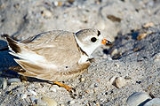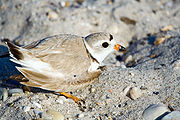
Quill Lakes
Encyclopedia

Wetland
A wetland is an area of land whose soil is saturated with water either permanently or seasonally. Wetlands are categorised by their characteristic vegetation, which is adapted to these unique soil conditions....
complex in Saskatchewan
Saskatchewan
Saskatchewan is a prairie province in Canada, which has an area of . Saskatchewan is bordered on the west by Alberta, on the north by the Northwest Territories, on the east by Manitoba, and on the south by the U.S. states of Montana and North Dakota....
, Canada
Canada
Canada is a North American country consisting of ten provinces and three territories. Located in the northern part of the continent, it extends from the Atlantic Ocean in the east to the Pacific Ocean in the west, and northward into the Arctic Ocean...
that encompasses the endorheic basin of three distinct lake wetlands: Big Quill Lake, Middle Quill Lake and Little Quill Lake. On May 27, 1987, it was designated a wetland of international importance
Ramsar list of wetlands of international importance
This is the list of wetlands of international importance as defined by the Ramsar Convention for the conservation and sustainable utilization of wetlands, recognizing the fundamental ecological functions of wetlands and their economic, cultural, scientific, and recreational value.The Convention...
via the Ramsar Convention
Ramsar Convention
The Ramsar Convention is an international treaty for the conservation and sustainable utilization of wetlands, i.e., to stem the progressive encroachment on and loss of wetlands now and in the future, recognizing the fundamental ecological functions of wetlands and their economic, cultural,...
. It was the first Canadian site in the North American Waterfowl Management Plan
North American Waterfowl Management Plan
The North American Waterfowl Management Plan is an international plan to conserve waterfowl and migratory birds in North America. It was established in 1986 by Canada and the United States, and expanded to include Mexico in 1994....
, is a site in the International Biological Programme and Saskatchewan Heritage Marsh Program, and was designated a Western Hemisphere Shorebird Reserve Network
Western Hemisphere Shorebird Reserve Network
The Western Hemisphere Shorebird Reserve Network is a conservation strategy targeting shorebirds in the Americas launched in 1985. Its aim is to protect the nesting, breeding and staging habitats of migratory shorebirds...
site of International significance in May, 1994. The site is an important staging
Staging area
A staging area is a location where organisms, people, vehicles, equipment or material are assembled before use.- In construction :...
and breeding area for spring and fall migration of shorebirds. The site qualifies as an Important Bird Area
Important Bird Area
An Important Bird Area is an area recognized as being globally important habitat for the conservation of bird populations. Currently there are about 10,000 IBAs worldwide. The program was developed and sites are identified by BirdLife International...
for its globally and nationally significant migratory and breeding populations of more than a dozen species of birds.
The lakes were named for bird quills collected near shorelines and shipped to England
England
England is a country that is part of the United Kingdom. It shares land borders with Scotland to the north and Wales to the west; the Irish Sea is to the north west, the Celtic Sea to the south west, with the North Sea to the east and the English Channel to the south separating it from continental...
for use as quill pens. Quill Lakes is Canada's largest saline lake, covering an area of about 635 square kilometre. Salinity varies within the lakes and with their water levels, but effectively limits the floral diversity of the region. Located directly north of Regina
Regina, Saskatchewan
Regina is the capital city of the Canadian province of Saskatchewan. The city is the second-largest in the province and a cultural and commercial centre for southern Saskatchewan. It is governed by Regina City Council. Regina is the cathedral city of the Roman Catholic and Romanian Orthodox...
and east of Saskatoon
Saskatoon
Saskatoon is a city in central Saskatchewan, Canada, on the South Saskatchewan River. Residents of the city of Saskatoon are called Saskatonians. The city is surrounded by the Rural Municipality of Corman Park No. 344....
, it is primarily provincial Crown land
Crown land
In Commonwealth realms, Crown land is an area belonging to the monarch , the equivalent of an entailed estate that passed with the monarchy and could not be alienated from it....
administered by the Fish and Wildlife Branch of Saskatchewan Environment. The surrounding area, consisting of glacial moraines
Moraine
A moraine is any glacially formed accumulation of unconsolidated glacial debris which can occur in currently glaciated and formerly glaciated regions, such as those areas acted upon by a past glacial maximum. This debris may have been plucked off a valley floor as a glacier advanced or it may have...
, is mostly used for agricultural
Agriculture
Agriculture is the cultivation of animals, plants, fungi and other life forms for food, fiber, and other products used to sustain life. Agriculture was the key implement in the rise of sedentary human civilization, whereby farming of domesticated species created food surpluses that nurtured the...
purposes. Big Quill Lake is pear-shaped and approximately 27 km long, measuring 18 km at its widest point. Middle Quill Lake, also known as Mud Lake, is the smallest of the three, about 6 km long and 3 km wide. Little Quill Lake is 24 km long and 11 km wide. Islands located on Middle Quill Lake have been designated provincial wildlife refuges to protect breeding colonies of American White Pelican
American White Pelican
The American White Pelican is a large aquatic bird from the order Pelecaniformes. It breeds in interior North America, moving south and to the coasts, as far as Central America, in winter....
and Double-crested Cormorant
Double-crested Cormorant
The Double-crested Cormorant is a member of the cormorant family of seabirds. It occurs along inland waterways as well as in coastal areas, and is widely distributed across North America, from the Aleutian Islands in Alaska down to Florida and Mexico...
.
Various studies have surveyed bird populations at this site. The International Shorebird Survey in 1988 counted 155,000 shorebirds at Big Quill Lake. Surveys between 1989 and 1992 at Middle and Little Quill Lakes found one-day peaks of 101,900 birds. The most comprehensive study conducted, involving all three lakes, resulted in a count of 197,155 birds. The site is an important staging and breeding area for the endangered Piping plover
Piping Plover
The Piping Plover is a small sand-colored, sparrow-sized shorebird that nests and feeds along coastal sand and gravel beaches in North America. The adult has yellow-orange legs, a black band across the forehead from eye to eye, and a black ring around the neck...
. Other species identified throughout the complex include "85,000 geese, 100,000 ducks, [and] 12,000 cranes", as well as the Black-bellied Plover
Grey Plover
The Grey Plover , known as the Black-bellied Plover in North America, is a medium-sized plover breeding in arctic regions. It is a long-distance migrant, with a nearly worldwide coastal distribution when not breeding....
, Sanderling
Sanderling
The Sanderling is a small wader. It is a circumpolar Arctic breeder, and is a long-distance migrant, wintering south to South America, South Europe, Africa, and Australia...
s, Hudsonian Godwit
Hudsonian Godwit
The Hudsonian Godwit, Limosa haemastica, is a large shorebird.-Identification:Adults have long dark legs and a long pink bill with a slight upward curve and dark at the tip. The upper parts are mottled brown and the underparts are chestnut. The tail is black and the rump is white...
, Red Knot
Red Knot
The Red Knot, Calidris canutus , is a medium sized shorebird which breeds in tundra and the Arctic Cordillera in the far north of Canada, Europe, and Russia. It is a large member of the Calidris sandpipers, second only to the Great Knot...
, Stilt Sandpiper
Stilt Sandpiper
The Stilt Sandpiper, Calidris himantopus or Micropalama himantopus, is a small shorebird; it bears some resemblance to the smaller calidrid sandpipers or "stints". DNA sequence information is incapable of determining whether it should be placed in Calidris or in the monotypic genus Micropalama...
, White-rumped Sandpiper
White-rumped Sandpiper
The White-rumped Sandpiper is a small shorebird.Adults have black legs and a small thin dark bill. The body is dark brown on top and mainly white underneath, with brown streaks on the breast and a white rump. They have a white stripe over their eyes. This bird shows long wings in flight. In winter...
, Semipalmated Sandpiper
Semipalmated Sandpiper
The Semipalmated Sandpiper, Calidris pusilla, is a very small shorebird. It is sometimes separated with other "stints" in Erolia but although these apparently form a monophyletic group, the present species' old genus Ereunetes had been proposed before Erolia.Adults have black legs and a short stout...
, Long-billed Dowitcher
Long-billed Dowitcher
The Long-billed Dowitcher, Limnodromus scolopaceus, is a medium-sized shorebird.Adults have yellowish legs and a long straight dark bill. The body is dark brown on top and reddish underneath with spotted throat and breast, bars on flanks. The tail has a black and white barred pattern...
, Red-necked Phalarope
Red-necked Phalarope
The Red-necked Phalarope, Phalaropus lobatus, is a small wader. This phalarope breeds in the Arctic regions of North America and Eurasia. It is migratory, and, unusually for a wader, winters at sea on tropical oceans....
, [and] Lesser Yellowlegs
Lesser Yellowlegs
The Lesser Yellowlegs is a medium-sized shorebird similar in appearance to the larger Greater Yellowlegs. It is not closely related to this bird, however, but instead to the much larger and quite dissimilar Willet; merely the fine, clear and dense pattern of the neck shown in breeding plumage...
". Additionally, in the mid-1990s several Whooping Crane
Whooping Crane
The whooping crane , the tallest North American bird, is an endangered crane species named for its whooping sound. Along with the Sandhill Crane, it is one of only two crane species found in North America. The whooping crane's lifespan is estimated to be 22 to 24 years in the wild...
s were observed using the area for staging during fall migration.
Drought in the surrounding regions results in increased water draw from the lakes, reducing the water level and increasing its salinity. This reduces the breeding habitat for the Piping plover.
Big Quill Resources (taken over by Sifto Canada
Sifto Canada
Sifto Canada is a salt mining and marketing company based in Canada, with its primary products being table salt, fine evaporated salt, water conditioning salt, agricultural salt, coarse salt, rock salt, and bulk salt...
in 2011) operates on the shore of Big Quill Lake extracts naturally occurring sulphate from the brine of the lake then combining it with potassium chloride to form sulphate of potash that is the sold as a fertilizer.
External links
- Quill Lakes - Encyclopedia of Saskatchewan

